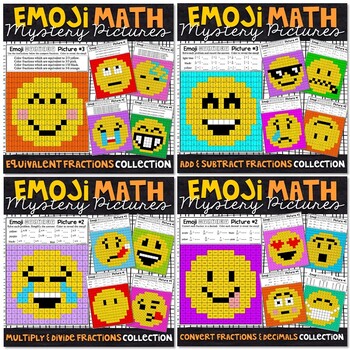Emoji FRACTIONS Mystery Pictures Bundle | Fractions Color by Number Bundle
- Zip
What educators are saying
Products in this Bundle (4)
Also included in
- Your students will have fun practicing math skills as they solve emoji mystery pictures. By purchasing the growing bundle, you will have all current Emoji Math Mystery Pictures sets at at 30% discount and receive all future sets (excluding seasonal, holiday, Message Math, and Partner Pictures setsPrice $99.75Original Price $142.50Save $42.75
Description
Your students will have fun with fraction problems as they solve emoji mystery pictures! Students solve math problems and color by code. Teachers save 20% by purchasing this bundle!
Purchase the GROWING BUNDLE and save 30% on all current emoji mystery pictures and get future sets for FREE
Here's a description of each set in The Fractions Bundle:
EQUIVALENT FRACTIONS
This set of math mysteries reviews the following:
- Comparing fractions using benchmark fractions
The following Common Core Standards are included:
4.NFA.2 – Compare two fractions with different numerators and denominators by creating common denominators or numerators
ADDING AND SUBTRACTING FRACTIONS
This set of math mysteries reviews the following:
Adding fractions with like denominators
Subtracting fractions with like denominators
Adding fractions with unlike denominators
Subtracting fractions with unlike denominators
Adding and subtracting mixed numbers
The following Common Core Standards are included:
4.NFB.3 - Understand addition and subtraction of fractions
5.NF.B.3 - Add and subtract fractions with unlike denominators (including mixed numbers)
MULTIPLYING AND DIVIDING FRACTIONS
This set of math mysteries reviews the following:
Multiplying a fraction by a whole number
Multiplying a fraction by a fraction
Dividing unit fractions by whole numbers
Dividing whole numbers by unit fractions
Dividing fractions by fractions
The following Common Core Standards are included:
4. NF.B.4 - Multiply a fraction by a whole number
5.NFB.4 - Multiply a fraction or whole number by a fraction
5.NFB.7 - Divide unit fractions by whole numbers and whole numbers by unit fractions
6.NS.A.1 - Interpret and compute quotients of fractions
CONVERTING FRACTIONS AND DECIMALS
This set of math mysteries reviews the following:
Using models to name decimals
Converting fractions with denominators of 10 to decimals
Converting fractions with denominators of 100 to decimals
Converting decimals to fractions with denominators of 10
Converting decimals to fractions with denominators of 100
The following Common Core Standards are included:
4.NFC.6 – Use decimal notation for fractions with denominators 10 or 100
~For personal and single classroom use only.~



